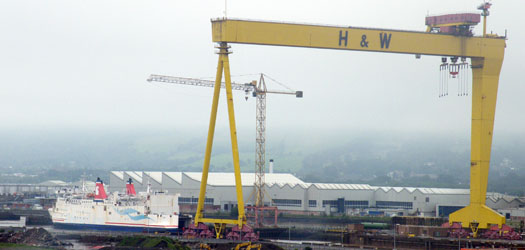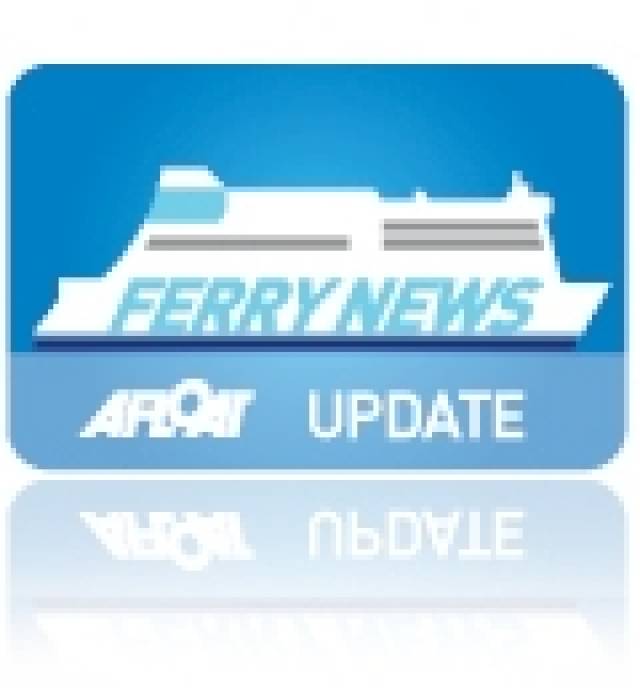#CycleFerry – Only seconds into the Giro d'Italia Discover Northern Ireland TV advert, there's a fleeting glimpse of a Harland & Wolff built ferry that was involved in the logistics of the last prestigious cycling race to this island, the Tour de France in 1998, writes Jehan Ashmore.
The footage shows Belfast's iconic yellow shipyard gantry cranes, Samsun and Goliath, (this weekend flooded at night in pink to reflect Giro D'Italia's pink jersey) and the former Stena Line ferry, Stena Caledonia.
As previously reported on Afloat.ie she was sold to Indonesian interests and renamed Port Link. Following the end of the three stages of the Tour de France, Stena Caledonia carried out a special chartered sailing for the cycling's vehicle entourage from Rosslare to Roscoff.
The Wexford-Breton route then, nor now, is operated by the company, though this Spring Stena Line acquired the operations of Celtic Link Ferries route to Cherbourg. Stena's first ever Ireland-continent route is served by Stena Horizon, an Italian flagged ro-pax ferry registered in Bari. After the three Irish stages, the Adriatic port is incidently the destination to where the first 'Italian' stage of the 97th Giro d'Italia finishes next Tuesday.
Likewise to the three stages of the Tour de France, the logistics involved were not only confined to Rosslare. As additional charters of two other Stena Line ferries were drafted in, Stena Challenger and Koningin Beatrix which called to Cork (Ringaskiddy ferry terminal), a first for the company. The pair also sailed to Roscoff.
Returning to the Stena Caledonia, as seen in the Giro D'Italia advert, she was berthed under the shadow of the giant gantry cranes at the Queen Island berth until her sale to PT ASDP Indonesia Ferry (Persero) and delivery voyage from Belfast Lough in 2012 as Port Link.

Portlink berthed at Belfast, close to the H&W shipyard cranes, the vessel is seen on the Giro d'Italia as the previously named Stena Caledonia, noting full Stena Line corporate livery and stern bridge. Photo Jehan Ashmore
She was the final member of a quartet of 'Saint' class ferried ordered for original owners, Sealink / British Rail and launched in 1981 as St. David.
Of the foursome, she was the only one designed with a stern-bridge so to ease operations during berthing in the restricted confines of the inner harbour in Holyhead while on the Dun Laoghaire route, in which she seldom served.
It was also apt that yesterday's 'Grande Partenza' or Big Start, saw the cyclist team trails set off from the Titanic Quarter, at the site to where a former slipway once occupied another ship built at the yard', the White Star liner RMS Titanic in 1912.
Only three years previously the Giro d'Italia was founded in 1909 and after a century later (with exceptions due to two world wars), the start of this year's Giro has for the first time begun outside mainland Europe.






























































